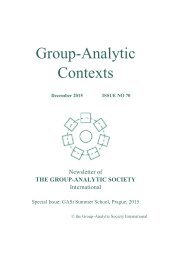Group-Analytic Contexts, Issue 80, June 2018
Create successful ePaper yourself
Turn your PDF publications into a flip-book with our unique Google optimized e-Paper software.
Newsletter – Summer <strong>2018</strong> 57<br />
a direct impact on the way the group acted on this Tuesday, even<br />
before the group session started. Nearly every group member entering<br />
the room asked me to have an individual session if possible. I thought:<br />
What is going on here? And during the session the theme was whether<br />
there would be enough time and space for all. One group member was<br />
very angry. She attacked another group member, who stayed very<br />
calm indeed and rejected the accusations, that actually, I think, were<br />
intended for me. Entering the room, every group member was a bit<br />
upset about this session because seven group members wanted to talk<br />
about the way they had got along during the break and they wanted to<br />
introduce themselves to the new group member. The angry group<br />
member expressed the rage of all the group members. For the new<br />
group member, what was happening was very strange and she left the<br />
first group session upset. I think the “temperature” was a bit too ‘hot’<br />
for her first participation. Her family situation: Her mother died when<br />
she was about eleven years old after long years of suffering (cancer).<br />
Her father never spoke to her or her younger sister about their<br />
mother’s death, but quickly married again, to a widow with three<br />
daughters. The stepmother was similar to those in fairy tales and her<br />
father didn’t protect her.<br />
Condensation of the group process and increase in the possibilities<br />
of working through the transference<br />
<strong>Group</strong> therapy expands not only the number of available objects but<br />
also of opportunities for transference. The group forces each member<br />
to recognize the uniqueness of their own way of seeing and<br />
interpreting the world, his relations, all issues. In concurrent or<br />
combined therapy, the possibility to have shared experience because<br />
therapist and patient are in the same group is a real treasure. It is really<br />
interesting to talk about events that happened in the group.<br />
Every member becomes aware of the fact that their own view<br />
of the world is massively influenced by their own biography. I call it<br />
“biographically coloured glasses”. A repetitive theme in all groups is:<br />
“Will I get enough space and attention…?” In a family, every member<br />
wants to get a piece of the cake.<br />
I want to quote the Rolling Stones: “You can’t always get<br />
what you want, but if you try some time, you find, you get what you<br />
need.” The early wishes can neither be fulfilled by the psychoanalyst<br />
nor by the group. This is a weighty insight and grief is necessary to<br />
get over it. Then, patients learn to share time and space and the group<br />
leader. When the group process develops well they recognize that they<br />
do not need as much as they thought they would need in the beginning













